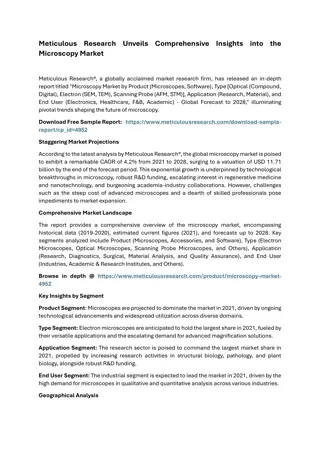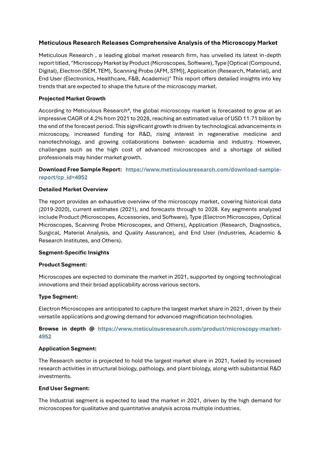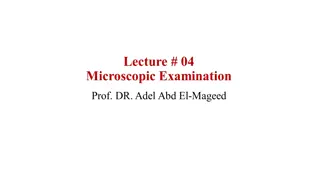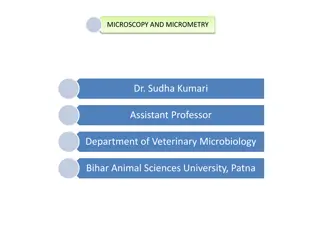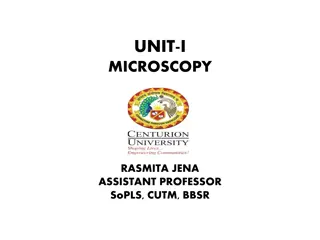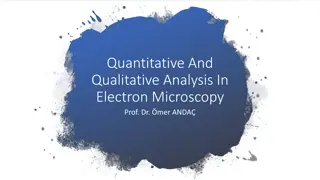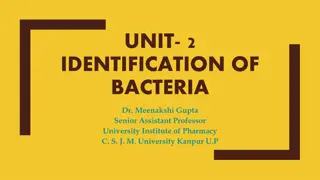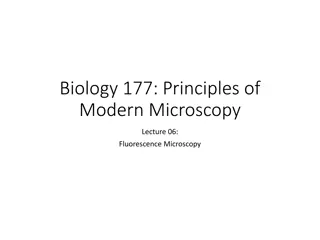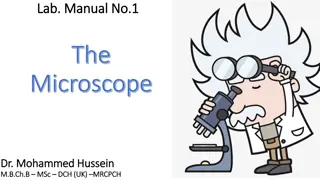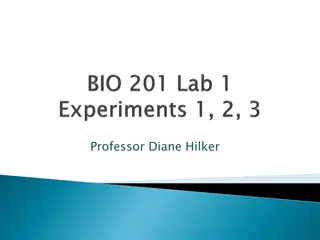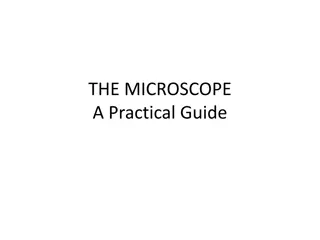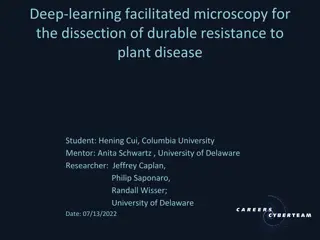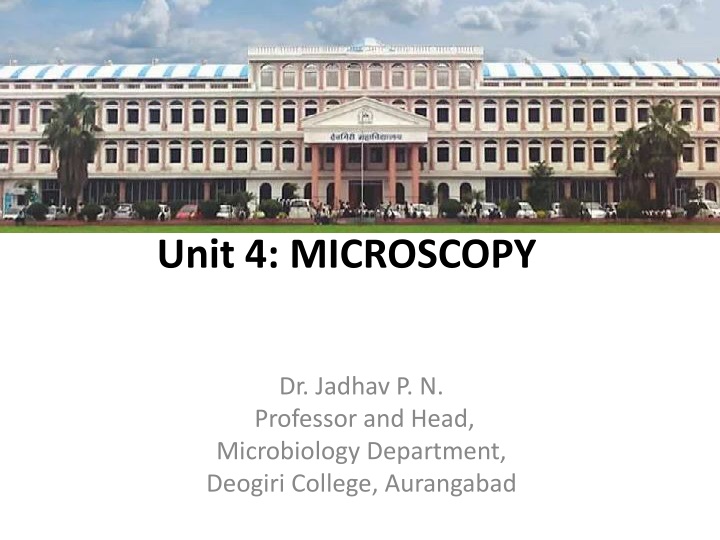
Exploring Microscopy: Types and Applications
Discover the fascinating world of microscopy with a focus on different types of microscopes such as compound, electron, fluorescence, and phase-contrast. Learn about their functions, advantages, and applications in microbiology. Calibration techniques and specific features of each microscope are also explored for a comprehensive understanding of microscopy techniques.
Download Presentation

Please find below an Image/Link to download the presentation.
The content on the website is provided AS IS for your information and personal use only. It may not be sold, licensed, or shared on other websites without obtaining consent from the author. If you encounter any issues during the download, it is possible that the publisher has removed the file from their server.
You are allowed to download the files provided on this website for personal or commercial use, subject to the condition that they are used lawfully. All files are the property of their respective owners.
The content on the website is provided AS IS for your information and personal use only. It may not be sold, licensed, or shared on other websites without obtaining consent from the author.
E N D
Presentation Transcript
B. Sc. First Year Semester I Paper I Fundamentals of Microbiology Unit 4: MICROSCOPY Dr. Jadhav P. N. Professor and Head, Microbiology Department, Deogiri College, Aurangabad
Types of microscopes Compound microscope have two sets of lenses (objectives and oculars) that use visible light as the source of illumination. Darkfield Microscopes have a device to scatter light from the illuminator so that the specimen appears white against a black background. Electron Microscopes use a flow of electrons, instead of light, to produce an image. They enhance images of viruses, ribosomes, proteins, lipids and even small molecules. Fluorescence Microscopes use an ultraviolet light source to illuminate specimens that will fluoresce. Usually a fluorescent dye or antibody has been added to the specimen that is being viewed. Phase contrast microscopes allow examination of structures inside the cells by using a special condenser. They take advantage of different refractive indexes and allows for examination of live organisms, because it is unnecessary to stain the cells to give good differentiation of parts. The final image is a combination of light and dark to produce the image.
Calibration of ocular micrometer Stage micrometer (objective micrometer) has calibration lines or graduations that are separated 0.01 mm (10 m) apart. Calibration achieved by superimposing the two scales and determining how many ocular graduation coincide with graduations on stage micrometer. Ocular micrometer with retaining ring inserted into the eyepiece s base Stage micrometer positioning by centering the small glass disk over the light source After completed calibration, specimen s slide is positioned for measurement
Compound Microscope Series of lenses for magnification. Light passes through specimen into objective lens Oil immersion lens increases resolution. Resolution=200nm ADVANTAGES Used to view live or stained cells. Simple setup with very little preparation required. DISADVANTAGES Biological specimen are often of low contrast and need to be stained. Staining may destroy or introduce artifacts.
Electron Microscope Co-invented by Max knoll and Ernst Ruska in 1931. Electron Microscopes uses a beam of highly energetic electrons to examine objects on a very fine scale. Magnification can upto 2million times while best light microscope can magnify up to 2000 times.
TEM Stream of electrons is formed. Accelerated using a positive electrical potential. Focused by metallic aperture and Electro magnets. Interactions occur inside the irradiated sample which are detected and transformed into an image.
SEM Used to study surface features of cells and viruses. Scanning Electron microscope has resolution 1000 times better than Light microscope OPTICS OF SEM
Phase contrast microscope First described in 1934 by Dutch physicist Frits Zernike Produces high-contrast images of transparent specimens. Principle Of Phase Contrast Microscopy : It is an optical illumination technique in which small phase shifts in the light passing through a transparent specimen are converted into contrast changes in the image. Light rays in phase produce brighter image. Light rays out of phase form darker image. Contrast is due to out of phase rays.
ADVANTAGES Phase contrast enables visualization of internal cellular components. Diagnosis of tumor cells . Examination of growth, dynamics, and behavior of a wide variety of living cells in cell culture. Ideal for studying & interupting thin specimen. DISADVANTAGES Annuli or ring limits the apperature to some extents which causes decrease in resolution. Not ideal for thick specimen. Shade off and Halo effect may occur.
Dark field microscope Produces a bright image of the object against a dark back ground. Optical system to enhance the contrast of unstained bodies. Specimen appears gleaming bright against dark background. Useful in demonstrating : Treponema pallidum ; Leptospira ; Campylobacter jejuni ; Endospore ADVANTAGES: Simple setup Provides contrast to unstained tissue,so living cells can be viewed. DISADVANTAGES: Specimen needs to be strongly illuminated which can damage delicate samples.
Fluorescence Microscope Exposes specimen to ultraviolet, violet, or blue light. Specimens usually stained with fluorochromes. Shows a bright image of the object resulting from the fluorescent light emitted by the specimen. Principle Of Fluorescence Microscopy : Certain dyes, called as fluorochrome after absorbing UV rays raised to a higher energy level. When the dye molecules return to their normal state, they release excess energy in the form of visible light (fluoroscence). Use Of Fluorescence Microscopy : Auramine Rhodamine - Yellow fluorescence Tubercle bacilli ; Acridine Orange R - gives orange red fluorescence with RNA and yellow green fluorescence with DNA ; QBC ; Immunofluorescence



